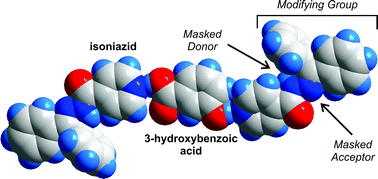Covalent assistance in supramolecular synthesis: in situ modification and masking of the hydrogen bonding functionality of the supramolecular reagent isoniazid in co-crystals†
Abstract
The supramolecular reagent

* Corresponding authors
a
Molecular Sciences Institute, School of Chemistry, University of the Witwatersrand, Johannesburg, South Africa
E-mail:
Andreas.lemmerer@wits.ac.za
Fax: +27 11 717 6749
Tel: +27 11 717 6711
b
Department of Chemistry, Ben-Gurion University of the Negev, Beer-Sheva, Israel
E-mail:
yoel@bgu.ac.il
Fax: +972 8 647 2943
Tel: +972 8 647 2455
c
Institute of Mineralogy and Petrography, University of Innsbruck, Innsbruck, Austria
Fax: +43 512 507 2926
Tel: +43 512 507 5503
The supramolecular reagent

 Please wait while we load your content...
Something went wrong. Try again?
Please wait while we load your content...
Something went wrong. Try again?
A. Lemmerer, J. Bernstein and V. Kahlenberg, CrystEngComm, 2011, 13, 5692 DOI: 10.1039/C1CE05152K
To request permission to reproduce material from this article, please go to the Copyright Clearance Center request page.
If you are an author contributing to an RSC publication, you do not need to request permission provided correct acknowledgement is given.
If you are the author of this article, you do not need to request permission to reproduce figures and diagrams provided correct acknowledgement is given. If you want to reproduce the whole article in a third-party publication (excluding your thesis/dissertation for which permission is not required) please go to the Copyright Clearance Center request page.
Read more about how to correctly acknowledge RSC content.
 Fetching data from CrossRef.
Fetching data from CrossRef.
This may take some time to load.
Loading related content
